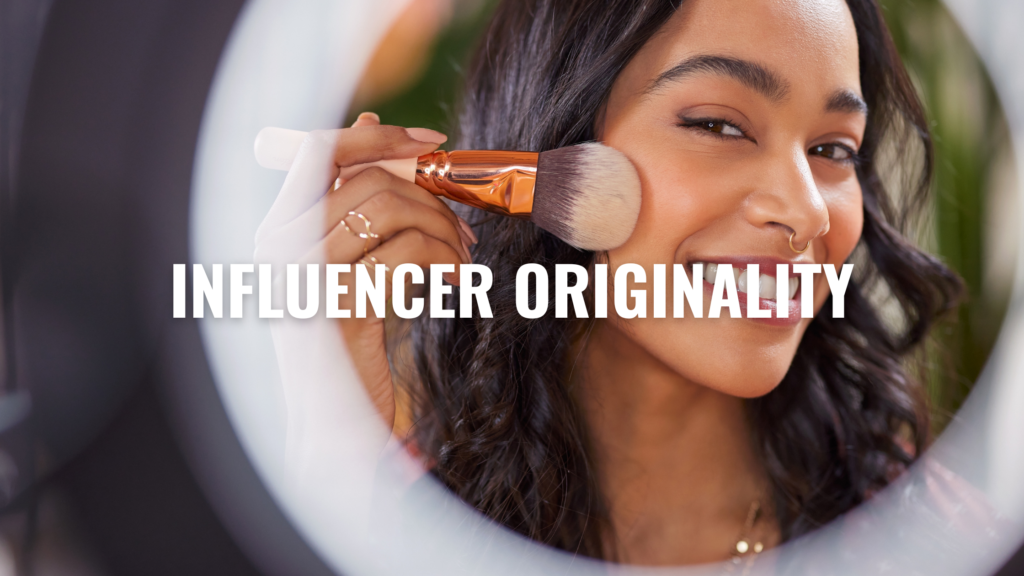One of the most-used buzzwords for 2025 is authenticity. However, it’s more than just a buzzword when it comes to marketing and messaging. Social media is continuing to change how we communicate with each other and how businesses reach consumers.
That change has been rapid and it has caused an influx of noise and distractions that can sometimes drown out the “signal” that brands or marketers want audiences to hear.
Table of Contents
- Authenticity Is Complex When It Comes To Social Media Creators
- Scientific Study Of Influencer Authenticity And Consumer Sentiment
- Different Stakeholders May View The Pillars Of Authenticity Differently
- Influencer Expertise
- Influencer Connectedness
- Influencer Integrity
- Influencer Originality
- Influencer Transparency
- Final Tips For Maintaining Authenticity
- Get Industry-Leading Advice For Your Next Influencer Marketing Campaign
This is where authenticity comes into play for 2025 and beyond. Authenticity is what’s going to break through the noise and allow the best influencer marketing agencies and brands to succeed with their influencer marketing strategies.
As consumers become more savvy and more careful with their time, they’ll seek out authenticity when it comes to the creators and brands they choose to engage with.
In this guide, we’ll dive into what authenticity means for influencer marketing in 2025 by taking a look at a comprehensive study into the subject by Barbara Duffek, who is an assistant professor of marketing at Georgia State’s Robinson College of Business.
Authenticity Is Complex When It Comes To Social Media Creators
The key to understanding authenticity is that the term is extremely flexible and can encompass a variety of behaviors and traits. One common misconception when it comes to authenticity and social media is that it requires the subject matter or the influencer to be extremely serious.
For example, an influencer who focuses on a cause that’s important to them is often seen as authentic. In that case, the influencer is, but it’s also generally serious subject matter that they’re covering.
However, an influencer can also be authentic by being silly, like a comedian who has their own podcast. They may cover obscure and silly topics on their podcast while cracking jokes, but the audience still feels a sense of authenticity that the comedian is saying what they truly believe.
The reason this is important is because some brands believe that to increase authenticity, they have to make their messaging more serious or work with influencers who have a more serious tone.
While this is necessary in some cases depending on the messaging of your campaign, it’s not a requirement. Just like in the example, a comedian making sophomoric jokes can be extremely authentic.
Being able to spot this authenticity and understand how it varies from niche to niche is a key talent of successful influencer marketers when developing a campaign strategy.
Scientific Study Of Influencer Authenticity And Consumer Sentiment
So far, discussing influencer authenticity can seem somewhat nebulous and difficult to define at times. That may be partially true, but researchers have studied this area of marketing and they’ve uncovered some very interesting data that can help you boost authenticity and understand its impact.
Barbara Duffek, an assistant professor of marketing at Georgia State’s Robinson College of Business, published a paper that dives into authenticity and how it’s seen from different perspectives, including both brands and consumers.
The results are fascinating and this is must-know information for anyone involved with influencer marketing in 2025.
To start, there were some key findings that Duffek uncovered regarding authenticity. In short, authenticity is made up of 5 key pillars when it comes to consumers and what they perceive as authentic.
1. Expertise: Consumers feel that an influencer’s expertise in a subject is a key factor in whether or not they are authentic. Of course, this varies by niche as more technical areas will depend much more on expertise than a niche like entertainment or lifestyle vlogs.
2. Connectedness: The relationship that the influencer has with the audience is the next core component of authenticity. This includes how much the influencer engages with the audience through comments and whether the influencer responds to what their audience wants or asks about. The stronger this connection, the more authentic that consumers believe the influencer is.
3. Being Original: Social media is filled with copycats trying to quickly gain followers or make a video go viral. While these accounts can get popular, they lack authenticity according to Duffek’s research. Originality can refer to content, style, or some other factor. But whatever it is, something about the influencer needs to set them apart from the crowd to achieve maximum authenticity in a crowded space.
4. Transparent: FTC regulations force many influencers to be transparent about partnerships. However, many try to operate in a gray area where payments or other compensation is not always fully disclosed. What Duffek found was that the more transparent an influencer is, the more authentic the audience perceives them. It’s important to note that audiences understand that popular influencers can make a lot of money, and they’re fine with it as long as there’s full disclosure.
5. Influencer Integrity: Integrity may seem similar to authenticity, and it is. But in this context, it means that the influencer truly has passion for the subjects they cover. This passion bleeds over into partnerships and endorsements, and allows the audience to have more trust when the influencer suggests a product.
These Authenticity Indicators Are Fluid
An influencer doesn’t need to be strong in every area to have authenticity. Using the previous example of a comedian who has a popular podcast, they may lack expertise in many areas (other than comedy) but still be seen as authentic if they make up for it in the other areas.
So there doesn’t need to be an equal amount of each component and it’s very niche dependent. Some influencers will excel in some areas while others will not. The key is to match their subject matter with the authenticity attribute that matters most.
For example, if you’re selling a technical product to a savvy audience, expertise will be what you look for to ensure authenticity. Many review-style accounts will pop up when a new and popular product category hits the market. However, they’re not all experts. Looking deeper into their background for expertise will help you find the most authentic influencers to partner with in that specific niche.
Different Stakeholders May View The Pillars Of Authenticity Differently
Now that we know what factors contribute to authenticity with influencers, it’s important to understand how different stakeholders in the chain view each of these. Surprisingly, there can be conflicts in this area as the brand manager and others in the marketing department have different priorities, and may prioritize different attributes when seeking out influencers.
For example, some stakeholders in a brand partnership deal may prioritize ROI above all else. That mostly makes sense, and if a campaign has a high ROI, it must be doing something right.
However, there could be a lack of several pillars from earlier that can erode the brand trust over time. This happens too often to brands that flood social media platforms with a similar message.
Suddenly, consumers see every influencer talking about the same product and it inevitably drives sales and conversions. However, over time, consumers start to see this is clearly an inauthentic ad campaign.
When this happens, there is a loss of integrity and transparency, which are two pillars of authenticity. Integrity for an influencer means they have some intrinsic motivation to promote a particular product or partner with a brand.
Once consumers see every influencer parroting the same talking point, that integrity is shattered and consumers quickly see the influencer had no intrinsic motivation, and was simply operating out of financial gain.
This is important because a stakeholder in charge of overseeing the health of the brand and the team measuring ROI would likely have two very different views of this situation.
This is why it’s critical that each stakeholder closely look at which components of authenticity are being prioritized and which may be sacrificed. You want to find a balance here so that you don’t go too far in one direction.
In the next sections, we’ll dive deeper into how each of the pillars of authenticity interact and how they work.
Influencer Expertise
[Image idea: For each of these five headings, use a photo of an influencer with the text for each heading]

According to Duffek’s research, influencer expertise doesn’t necessarily have to involve formal training or domain recognition. For example, an influencer that tries all the new trends in a given field can be seen as having expertise despite not claiming to be an actual expert.
The influencer’s knowledge of trends and industry changes is enough for them to be seen as an expert by their audience.
It’s important that brands recognize this because it opens more possibilities for brand partnerships at lower costs that still maintain a core aspect of authenticity.
Another interesting finding regarding expertise is if the influencer documents their own personal struggles. While we often think of an expert easily performing a task, an influencer who documents their struggles in a specific area often builds their expertise with an audience.
So this relatability is a key aspect of expertise even though on the surface, it may be counterintuitive. The reason is the audience wants to know that the influencer understands their own pain points.
Finally, expertise is also defined by consistent content production within a specific niche. Influencers who cover a variety of topics or post infrequently are often seen as less of an expert than others.
Influencer Connectedness

Connectedness refers to how an audience feels engaged with and relates to an influencer. For consumers, this is a key factor in deciding whether an influencer is truly authentic or not.
Audiences want influencers to be relatable and to create a sense of community around the topics they share. Consumers value influencers who share real, unpolished moments, such as showing both their successes and struggles. This makes them feel like they can trust the influencer due to shared experiences.
Brand managers should seek out Influencers who also understand the importance of connectedness. These types of influencers look to build relationships with their followers by engaging in conversations and responding to comments.
While some influencers can build a following by being more aloof and ignoring connectedness, these influencers are often far less valuable for marketing purposes, despite their high follower counts.
Influencer marketing agencies are keen on this type of influencer and they usually see the results of connectedness in metrics such as engagement. Influencers with a connection to their audience and who prioritize interaction will generally have significantly higher metrics when promoting specific brands or products.
This doesn’t mean that engagement metrics are everything and it can often depend on what the campaign goals are. This can create a misalignment if the campaign goals are not carefully considered before the influencer selection takes place.
Another issue arises when brands want influencers to track detailed engagement data, such as clicks and conversions. Some influencers, especially in Asia, resist using these tracking tools because they feel it gives brands too much control over their content. They prefer to keep their audience interactions more organic.
This misalignment can hurt both influencers and brands. If influencers focus too much on numbers, they might lose their authenticity by chasing high engagement rather than staying true to their content. At the same time, brands that ignore the value of genuine connections may choose influencers who do not align with their brand values, leading to weaker marketing campaigns. To build successful partnerships, brands should recognize that long-term trust and connection matter just as much as immediate engagement metrics.
Some of these findings may seem contradictory. But on closer inspection, we see that they are dependent on campaign goals and brand messaging. When these are clearly defined, it becomes easier to find the right balance of connectedness and strong metrics.
Influencer Integrity

Integrity means an influencer is honest and motivated by more than just money. Generally, this is described as the influencer having an intrinsic desire to create content, and consumers value this highly. They want influencers to share real opinions and not just promote products for payment. If an influencer constantly posts paid ads, people may stop trusting them. Consumers understand influencers need to make money and often cheer for the influencer to have more success, but prefer when they are selective about brand partnerships and various sources of income.
Influencers know that working with too many brands can damage their integrity. Many influencers now choose partnerships carefully to avoid looking like they are just in it for the money. One influencer in Duffek’s research said they didn’t want to be called a “sellout” after spending years building their brand. However, influencers still need income, so they sometimes struggle to balance integrity with sponsorship opportunities.
Brands and marketing agencies also need to value integrity, but for different reasons. They don’t expect influencers to work for free, but they should be aware that influencers who promote too many products will lose credibility. A marketing agency representative contacted for Duffek’s research said they avoid influencers who advertise similar products from different brands. If an influencer promotes multiple hair care brands, for example, it becomes unclear which one they truly believe in. This can hurt both the influencer’s and the brand’s reputation.
To solve this, savvy brands look for influencers whose values match theirs. If an influencer already uses a product, their promotion feels more genuine. One brand manager in the study explained that when an influencer’s lifestyle fits the brand, their endorsement seems more believable. Brands want to “piggyback” on the influencer’s reputation, so they need to choose influencers carefully. A misalignment here prevents the influencer’s reputations from rubbing off on the brand, which is what marketers are looking for.
If influencers promote too many brands, they lose trust. However, working with the same brand in a long-term partnership can solve this problem by allowing regular income to the influencer without the integrity loss that comes from promoting too many different products.
This is why many top influencer marketers look out for long-term partnerships when feasible.
Influencer Originality

Originality means influencers create content in a way that feels unique and natural. Consumers are drawn to influencers that are creative and make content that stands out. For marketing, they prefer when influencers tell unique stories and integrate products into their content in a way that feels organic.
For example, a consumer might appreciate an influencer testing a waterproof phone case by using it in a real-life situation at a pool rather than just listing its features in their podcast studio.
A conflict can occur due to influencers understanding that originality is important, but they still have to follow brand guidelines. It’s common for influencers to feel that when brands give them too many rules, the content feels forced and doesn’t connect with their audience. This hurts both the influencer and the brand.
Influencers want the freedom to present products in a way that fits the usual style that their audience expects. One influencer in the study mentioned turning down a brand’s request to create a heavily scripted ad because it simply didn’t match their usual content style.
This could have been avoided if the brand had more flexibility. However, a brand shouldn’t compromise its values just to partner with a specific influencer.
Marketing agencies agree that originality is key to influencer success. They should encourage influencers to maintain their unique style while promoting products. One agency representative in the study explained that consumers will know something is an ad, but it shouldn’t “feel” like an ad. That’s a delicate balance, but it’s necessary to optimize authenticity.
Still, brand managers often struggle with this. They want influencers to be creative but also ensure the brand’s message is clear. Some brand managers push for scripted content to control messaging, even if it makes the content feel less authentic. This creates a misalignment and there was likely a solution somewhere along the line that could have satisfied both aspects.
If brands don’t allow creativity, they miss out on content that feels more engaging and natural. The best approach is for brands to give influencers creative freedom while ensuring the key message is still communicated. When influencers can blend brand messaging with their own unique style, the content feels more authentic and resonates better with audiences.
This may seem obvious, but many campaigns fail due to a lack of balance between these opposing forces.
Influencer Transparency

Transparency means influencers are open about their brand partnerships and honest about various forms of cooperation or compensation. Audiences want influencers to clearly state when a post is sponsored and what input the brand had on the video. If an influencer hides sponsorships or always gives positive reviews, this can lead to transparency issues.
Influencers generally understand the importance of transparency, but they also face pressure from brands or sometimes just want to appear more neutral. Some brands prefer influencers not to mention that a post is an ad, thinking it will make the promotion more effective. However, influencers who do this risk losing credibility with their audience. Some influencers choose to be upfront about sponsorships and even continue promoting products they like after the paid campaign ends to show their genuine support.
Regulations or platform TOS agreements generally require some type of disclosure of paid promotion. However, as long as they reference a paid promotion, the influencer isn’t required to give details, which can impact transparency despite some degree of disclosure.
Generally, most agencies will want the influencer to be transparent, assuming there is a trust between the two parties.
Brand managers, however, sometimes prioritize positive messaging over transparency. They want influencers to highlight only the good aspects of a product and may discourage mentioning any flaws. This creates a misalignment because influencers and agencies value honesty, while brands often want to control the message completely.
This can be avoided if the influencer claims the brand has no input on the final content. That way audiences can feel as though the influencer was allowed to be totally transparent.
This type of misalignment can damage both influencers and brands. If influencers are not honest, their audience may stop trusting them. If brands push for only positive content, consumers may see it as fake, as the campaign is scaled across different influencers. The best approach is for brands to allow influencers to share balanced opinions, making endorsements feel more authentic and believable.
Final Tips For Maintaining Authenticity
Now that we’ve gone over the 5 pillars of authenticity according to Duffek’s research, we want to cover some actionable tips to help maintain authenticity while still keeping a strong marketing message intact.
Key Misalignments and Solutions
- Expertise & Connectedness
- Instead of choosing influencers based only on follower count, brands should focus on those who are knowledgeable in their niche and actively engage with their audience. Remember, expertise doesn’t need to be formal training or industry recognition. Simply being active in an industry can be enough to show expertise. Make sure to match your niche with what the audience expects as an expert.
- Integrity
- Consumers distrust influencers who promote too many brands without genuine connections. During the vetting process, look over an influencer’s feed and look at the percentage of sponsored content.
- Brands should prioritize long-term partnerships with influencers who already use or support their products. This allows the influencer to have a stable income while avoiding a loss of integrity with the audience.
- Originality vs. Brand Control
- Strictly scripted content can make influencer promotions feel inauthentic.
- Giving influencers creative freedom to present products in their unique style leads to more engaging content. This can be a delicate balance, but it’s critical to maintain authenticity and should be a clear focus when developing a content brief.
Best Practices for Brand Managers To Maintain Authenticity
- Choose influencers carefully based on audience trust, engagement, and brand alignment—not just reach. The vetting process is often the most critical when creating a successful campaign. If the wrong influencers are chosen, the campaign generally won’t work no matter how good it is.
- Encourage authentic content by allowing influencers to incorporate products naturally into their storytelling. Avoid heavy scripting and work closely with the influencer if they feel your content brief is too strict.
- Maintain transparency by requiring clear sponsorship disclosures but allowing honest reviews. Watch out for influencers who want to obscure paid promotions.
- Build long-term relationships so influencers feel invested in the brand rather than just taking one-off deals.
- Monitor audience feedback and adjust strategies to improve effectiveness. Influencers can change over time along with their style of content. You may need to adjust strategies as audiences and influencers change.
Get Industry-Leading Advice For Your Next Influencer Marketing Campaign
Authenticity is more than a buzzword. It’s now a critical aspect of social media marketing in 2025.
Since our founding in 2011, HireInfluence has been a leader in influencer marketing and our experience allows us to craft highly-engaging campaigns that are based on authenticity. The result is that our clients enjoy some of the highest ROIs possible on their ad spend.
Contact HireInfluence today to discuss your brand goals and learn why the top companies choose HireInfluence as their social media marketing partner.





